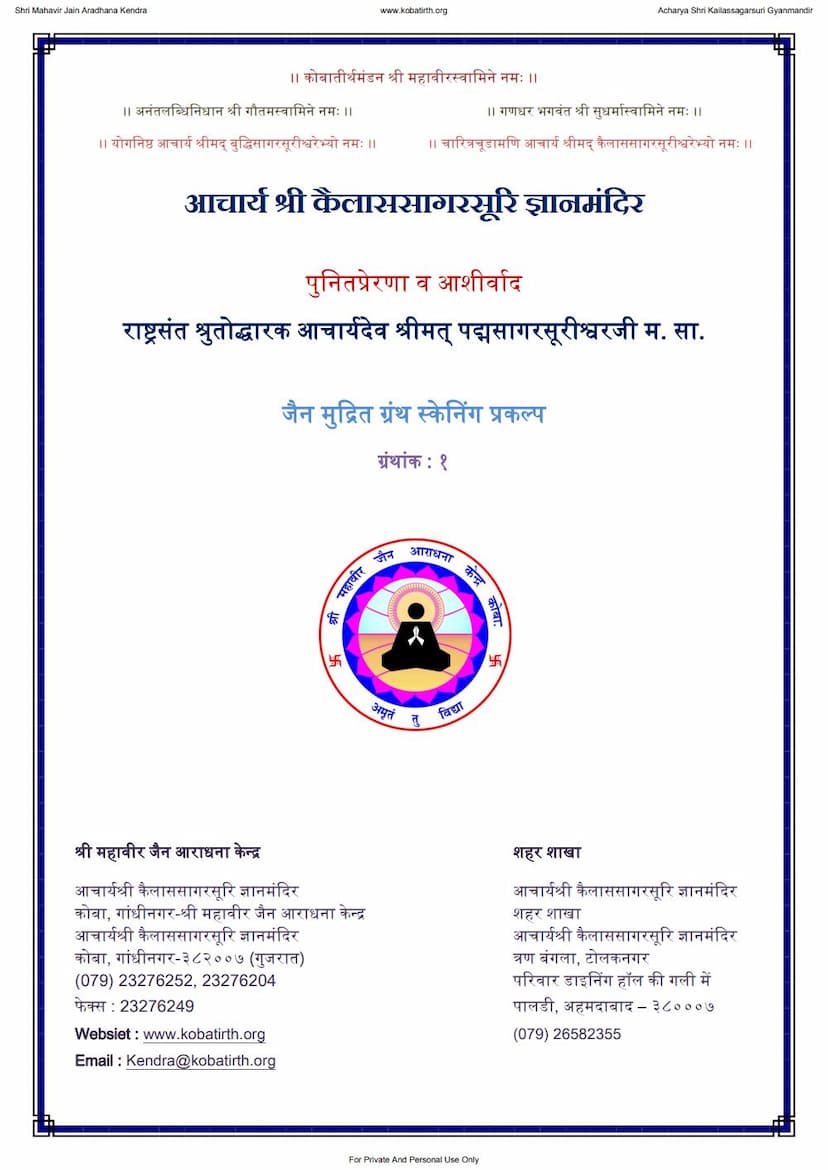Ssut Samhita
Added to library: September 2, 2025
Loading image...

Summary
The provided text is the beginning of the "Sūta Saṃhitā" (Sut Samhita) with the commentary "Tātparya Dīpikā" by Madhavacharya. The text itself is a compilation of hymns and philosophical discussions, primarily focused on the glorification of Lord Shiva.
Here's a summary of the provided pages:
Overall Context:
- The text belongs to the "Ānandāśrama Saṃskṛta Granthāvali" series, specifically "Sūta Saṃhitā" within the Skanda Purāṇa, with the commentary "Tātparya Dīpikā" by Śrī Mādhava Ācārya.
- It was published in 1893 by Mahādeva Chimnājī Āpaṭe at the Ānandāśrama Press.
- The document emphasizes it's for "Private And Personal Use Only."
- The initial pages include blessings and invocations to various Jain spiritual figures like Shri Mahavir, Gautam Swami, Sudharma Swami, and Acharya Kailassagarsuri. This is unusual for a text primarily focused on Shaivism, suggesting a Jain context for the archival or scanning project.
Key Content of the "Sūta Saṃhitā" (as presented in these initial pages):
- Invocation and Preface: The text begins with devotional verses and salutations to Lord Shiva (Parabrahma, Śrī Tryambaka, Śambhu, etc.). It mentions that the commentary "Tātparya Dīpikā" is by Madhavacharya, who aims to explain the essence of the Sūta Saṃhitā for the benefit of the less knowledgeable.
- Explanation of Shiva's Nature: The commentary starts by discussing the nature of Shiva, describing Him as both Niskala (formless) and Sakala (with form, like the Śiva-linga). The Niskala aspect is described as pure, self-luminous, and bliss-consciousness, while the Sakala aspect is linked to the Śiva-linga form.
- Praise of Shiva: Shiva is depicted as the ultimate reality, the cause of creation, sustenance, and destruction, beyond time and space, all-pervading, and self-established. He is also described as the basis of all existence, yet without a basis Himself.
- The Concept of Maya: The text touches upon Maya (illusion) as the power through which the world is created and the reason for the apparent duality and ignorance of the true nature of reality.
- The Dialogue Format: The text presents a dialogue between the sage Sūta and other sages (like Shaunaka), who pose questions about cosmology, the nature of deities, and spiritual practices. Sūta then answers these questions, drawing from the wisdom of the Puranas and Vedas.
- Enumeration of Puranas: The text lists the 18 Mahapuranas and 18 Upapuranas, highlighting the Skanda Purāṇa and its section, the Sūta Saṃhitā.
- Structure of Sūta Saṃhitā: The Sūta Saṃhitā is described as being divided into four sections (Khaṇḍa): Śiva Mahatmya Khaṇḍa, Jñāna Yoga Ākhya, Mukti Khaṇḍa, and Yajña Vaibhava Khaṇḍa. The initial chapters focus on the Śiva Mahatmya Khaṇḍa, starting with "Granthāvatāra" (Introduction to the text).
- Cosmological and Theological Discussions: The Sūta Saṃhitā, through Sūta's discourse, delves into the creation of the universe, the nature of time, the role of various deities (Brahma, Vishnu, Rudra), the concept of Pashu (souls bound by Pasas like mala, maya, karma), and the means to liberation.
- Practices and Devotion: The text emphasizes the importance of devotion (Bhakti) and specific rituals, like the Paśupata Vrata, as a path to understanding and ultimately merging with the divine.
- Inclusion of Jain Blessings: The presence of invocations to Jain Tirthankaras and Acharyas at the beginning of a text that otherwise heavily focuses on Shaivism is a significant detail. It suggests that this particular publication or archival effort might have been undertaken by a Jain organization or had a specific purpose related to Jain studies, perhaps for comparative religious analysis or as part of a broader project to preserve Indian religious literature.
In essence, these pages introduce the "Sūta Saṃhitā" as a Shaivite scripture, focusing on the supremacy and nature of Shiva, and begin its exposition through the dialogue format. The unusual Jain blessings at the start are a notable contextual element.